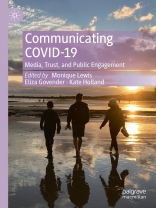This edited collection, follows on from ‘Communicating COVID-19: Interdisciplinary Perspectives’ (2021) and brings together different scholars from around the world to explore and critique the ongoing advances of communicating COVID, two years into the pandemic.
Pandemic life has become familiar to us, with all its disruptions and uncertainties. In the second year of COVID, many societies emerged well attuned to new waves of infections, while others, having initially demonstrated ‘gold standard’ responses, regressed, either through a premature end to public health restrictions or challenges around vaccine rollouts. In many countries, bitter social divisions have arisen over mask-wearing, lockdowns, quarantine and vaccination.
To better understand the ever evolving communicative landscape of COVID-19, this collection shares updated perspectives from the disciplines of media and communication, journalism, public health and primary care, sociology, and political and behavioural science, addressing the major issues that have confronted communicators, including vaccine hesitancy, misinformation, and the mobilisation of community driven communication responses as restrictions eased in various parts of the world.
Cuprins
Chapter 1: Introduction. Monique Lewis, Eliza Govender, Kate Holland.
Section 1: Public Interest Journalism, News, and Community Media.- Chapter 2: Community Radio in the Covid-19 Crisis: Lessons from global dialogues. Vinod Pavarala.
- Chapter 3: Answering Questions: Explanatory journalism and podcast ‘liveness’ during COVID. Mia Lindgren and Dylan Bird.
- Chapter 4: ‘We’re Losing Our Bread and Butter Like Never Before’: Journalism in the face of Covid-19 pandemic. Shaharior Rahman Razu.
- Chapter 5: The Covid-19 Pandemic in Portuguese Journalism. Rita Araujo et al.
- Chapter 6: Impact of Covid-19 on Journalistic Practices in Emerging Democracies. Sayyed Fawad Ali Shah and Faizullah Jah.
- Chapter 7: COVID and the Future of Journalism. David Nolan et al.
- Chapter 8: Media Depictions of Remote General Practice Care in a Protracted Pandemic. Gilly Mroz and Trish Greenhalgh.
-
Section2: Risk Communication and Community Engagement.
- Chapter 9: Perceptions of Risk and Self-Efficacy About COVID messaging in South African Townships. Mpume Gumede and Eliza Govender.
- Chapter 10. Rethinking Community Engagement For Research in Pandemic Times: Lessons from the future. Theresa Rossouw et al.
- Chapter 11: Application of the Extended Paralax Process Model in Cote D’Ivoire. Danielle Naugle.
- Chapter 12: ‘What’s Up, Fellow Deadly Diseases?’: Creative arts and communicating Covid-19 in Ghana. Ama de-Graft Aikins.
- Chapter 13: Much Ado about Covid-19 Vaccines: Understanding perceptions and experiences of vaccines among health care workers and its influence on patient COVID-19 communication in Eswatini hospitals. Nqobile Ndinzisa and Eliza Govender.
-
Section 3: Vaccine Communication and Digital Technologies.
- Chapter 14: COVID-19 and Aboriginal and Torres Strait Islander People in Australia: Can rhetoric equal action?. Kalinda Griffiths.
- Chapter 15: Far-right Political Extremism and the Radicalization of the Anti-vaccine Movement in Canada. Sibo Chen.
- Chapter 16: Harnessing Interpersonal Communication and Trusted Leadership to Increase COVID-19 Vaccination Uptake in Hard-to-Reach Wildlife Communities in Uganda. Barbara Natifu.
- Chapter 17: Function Creep of Covid-19 of Big-Data Surveillance in China. Ausma Bernot and Susan Trevaskes.
- Chapter 18: Identifying Novel COVID-19 Rumors Through a Multi-Channel Approach. Natalie Tibbels.
- Chapter 19: Creating Demand for COVID-19 Vaccines Through a Coordinated Social Media Campaign: Religious leaders and health experts. Stella Babalola.
-
Section 4: Theoretical and Philosophical Concepts for Understanding Covid Communication.
- Chapter 20: Values, Worldviews, Ideology and Reactance: Communication in a pandemic. Claire Hooker and Mat Marques.
- Chapter 21: Communicating Ableism in a Pandemic: Compassion, vulnerability and the violence of care. Michael Orsini.
- Chapter 22: Critical Health Literacy and Scientific Literacy as a Basis for Individual Appraisals of Health Information During Public Health Emergencies. Sarah Rubinelli et al.
- Chapter 23: TBC. Mark Davis.
- Chapter 24: Conclusion.
Despre autor
Monique Lewis is a communications scholar, sociologist, and lecturer in media and communication at Griffith University, Australia.Eliza Govender is Associate Professor and Head of Department of the Centre for Communication, Media and Society (CCMS), University of Kwa Zulu-Natal, South Africa.
Kate Holland is Senior Research Fellow in the News & Media Research Centre at the University of Canberra, Australia.












